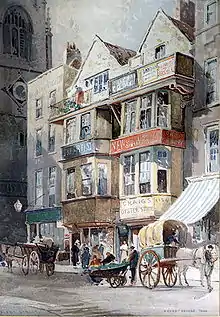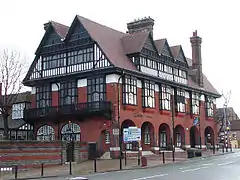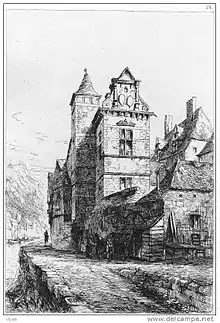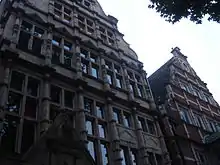Ernest George
Sir Ernest George RA (13 June 1839 – 8 December 1922) was a British architect, landscape and architectural watercolourist, and etcher.

Life and work
Born in London, Ernest George began his architectural training in 1856, under Samuel Hewitt, coupled with studies at the Royal Academy Schools 1857–59. After a short period in the office of Allen Boulnois, he went on a sketching tour of France and Germany, which inspired him to the architectural style that would make him famous.[1]
On his return to London, he set up an architectural practice in 1861 with Thomas Vaughan.[2] They had their breakthrough in 1869, when Ernest George was contacted by the tea and spice importer and Member of Parliament Henry Peek (son of James Peek who started the biscuit business Peak Frean & Co). He was about to buy the village of Rousdon in Devon, and wanted George to build him a large mansion house south of the village, plus several other buildings.[1] This complex became eventually known as the Rousdon Estate, and from 1930 to 1998 the George-designed mansion house served as the private boarding school Allhallows College.
Vaughn suddenly died in 1869, forcing George to find another partner. He chose the young Harold Peto, mainly because of the Peto family's vast contact network in the building industry. During this partnership, George designed houses in London for the Cadogan Estate in Chelsea and Kensington. In 1881 they designed Stoodleigh Court at Tiverton for Thomas Carew. In 1891 they designed an extension to West Dean House for William James, creating the Oak Room, now Oak Hall in West Dean College.
In 1891, Harold Peto decided to leave London for health reasons, and to devote more time to his interests in garden design, at which point George made a former pupil, Alfred Bowman Yeates, his new partner.
In New Zealand, which he never visited, he designed the Theomin family house Olveston in Dunedin which was built 1904–07.[3]
He was also responsible for the current Southwark Bridge (1921), and the Memorial to Heroic Self Sacrifice in London's Postman's Park.
He served as president of the Royal Institute of British Architects from 1908 to 1910.
Ernest George's London office was nicknamed "The Eton of architects",[2][4] and the 79 pupils included Herbert Baker, Guy Dawber, John Bradshaw Gass, Edwin Lutyens and Ethel Charles. Ethel Charles was the first woman to be elected a member of the Royal Institute of British Architects.[5]
George died in London at 71 Palace Court, Bayswater, in 1922 aged 83 and was cremated at Golders Green Crematorium, of which he and Alfred Yeates had been the architects[6] and where the Ernest George Columbarium is named for him.
George's residence at 17 Bartholomew St, London Borough of Southwark is commemorated with a Southwark Council blue plaque.[7]
Buildings by Ernest George

- Rousdon House (for Sir Henry Peek of Peek Freans; became Allhallows School in 1938) Rousdon, Devon (1870)
- 1-8 Collingham Gardens, Earls Court, London (1881–84)
- 4 & 6 Thornlaw Road, West Norwood, London (1882)
- Ossington Coffee Tavern, Newark on Trent (1882)[8]
- Shockerwick House, Bathford, Somerset including wings, lodge and 'The Clock House' (1896)
- Cawston Manor & Water Tower Cawston, Norfolk (1897)
- Golders Green Crematorium, London (1902)
- Eynsham Hall, Oxfordshire (1904–08)
- Olveston, Dunedin, New Zealand for David Theomin (1903)
- Ruckley GrangeTong, Shropshire (1904)
- Bushridge Hall, Godalming, Surrey (1906)
- Crathorne Hall, North Yorkshire (1906–09)
- Putteridge Bury, Lilley, Hertfordshire (1911)
- Royal Academy of Music, London, (1911)[9]
Painting
- George painted in England, Belgium, Holland, France, Germany and Italy.[10]
- An album with pencil-sketches of townscapes in Ostend, Belgium is kept in the Kunstmuseum aan Zee there [11]

Further reading
- H. Grainger, The Architecture of Sir Ernest George and his partners [Ph. D. thesis, University of Leeds] (1985)
References
- Times Higher Education, 7 July 2011: The Architecture of Sir Ernest George Linked 2017-02-06
- The Lutyens Trust: The Architecture of Sir Ernest George Linked 2017-02-06
- M. Blackman, Dorothy Theomin of Olveston (2007. The Friends of Olveston, Dunedin, NZ) ISBN 978-0-473-11564-7, pp.17-19.
- A. Stuart Gray, Edwardian Architecture, A Biographical Dictionary (1985), ISBN 0-7156-2141-6, p.186.
- Lynne Walker, "Golden Age or False Dawn? Women Architects in the Early 20th century", English-heritage.org. Retrieved 18 March 2012.
- Oxford Dictionary of National Biography, Volume 21. Oxford University Press. 2004. p. 914. ISBN 0-19-861371-7.
- "Sir Ernest George". Retrieved 14 August 2012.
- Pevsner, Nikolaus; Williamson, Elizabeth; Hartwell, Clare (2020). The Buildings of England. Nottinghamshire. Yale University Press. p. 368. ISBN 9780300247831.
- Gray, A. Stuart, Edwardian Architecture: A Biographical Dictionary, Wordsworth Editions, London, 1985 p.187
- Chisholm, Hugh, ed. (1922). . Encyclopædia Britannica. 31 (12th ed.). London & New York: The Encyclopædia Britannica Company. p. 219.
- N. Hostyn, Een album met Oostendse schetsen van Sir Ernest George. Een uitzonderlijk iconografisch document voor Oostende, [Ostend] [Kon. Oostendse Heem- en Geschiedkundige Kring De Plate], [2008]
External links
| Wikimedia Commons has media related to Ernest George. |
- The Lychgate, West Wickham Church (1864 watercolour)
- Ghent, Canal Scene (Etching, c. 1880)
- San Gimignano (1882 watercolour)
- The Rousdon Estate website

